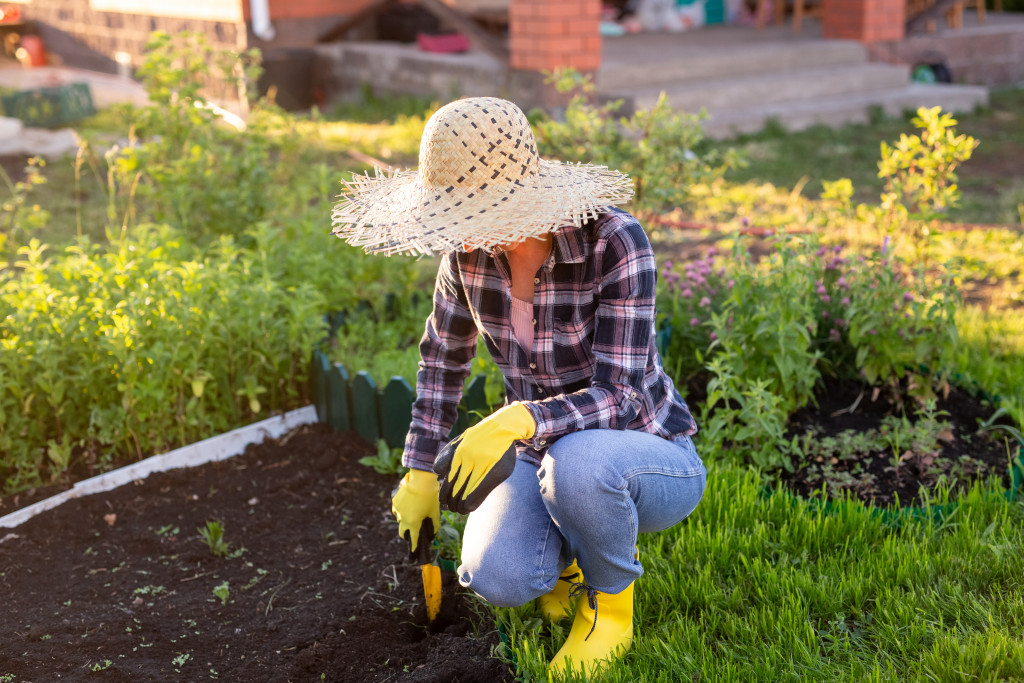-
- Preparing the area is essential for a successful vegetable garden, considering factors such as sun exposure, soil quality, and drainage.
- Eating vegetables from a garden can improve health due to the higher nutrients than those grown with chemical fertilizers or pesticides.
- Growing vegetables can help promote healthy eating habits and teach children about where their food comes from.
- Choosing the proper plants for your climate, along with mulches and row covers, will ensure optimal yields from your vegetable garden.
- Gothic arch greenhouses can protect your garden from extreme temperatures and weather conditions.
Building a vegetable garden can be a beneficial endeavor in many ways. First and foremost, having a vegetable garden can drastically reduce your grocery bill, save you money in the long run, and help you to reduce your carbon footprint. You’ll know exactly where your food comes from, meaning it is free of pesticides and other chemicals.
Moreover, with a vegetable garden, you can enjoy the benefits of fresh produce grown without added preservatives. Studies have shown that fresh vegetables contain more nutrients than those developed using chemical fertilizers or pesticides. Eating vegetables grown in your garden could improve health outcomes due to higher essential vitamins and minerals.
Access to fresh vegetables helps promote healthy eating habits for the whole family. It encourages people to make healthier choices regarding snacking or meals. Additionally, growing vegetables allows children to learn more about where their food comes from and how it’s produced. This could lead to them making healthier food choices as adults if they develop an appreciation for fresh vegetables early on.
However, building a vegetable garden requires some forethought and planning. Here are five steps to consider before getting started:
Prepare the Area

Having a vegetable garden requires appropriately preparing the area before planting. Properly preparing the space is essential to ensure that your plants have enough room to grow and thrive and provide access to sunlight and other resources such as water. Here are a few tips to ensure you properly prepare the area for vegetation:
Choose an Appropriate Spot
When selecting an appropriate spot for your vegetable garden, consider factors such as sun exposure, soil quality, drainage, accessibility, and size. Choose a location with at least 8 hours of direct sunlight daily. Additionally, ensure easy access for watering and harvesting vegetables without too much effort. The ideal size depends on your available space and how many vegetables you plan on growing.
Test Your Soil
Testing your soil’s pH level will give you insight into its nutrient levels so you can make any needed adjustments before planting. It is essential to understand what type of soil your garden has to choose which plants will thrive in it best. Add compost or other materials like manure or peat moss to improve soil fertility.
Clear Out Weeds
Weeds can quickly take over an area if they are not removed regularly, so getting rid of them before planting starts is essential. Use hand tools or chemical treatments if necessary, but ensure all weed debris is cleared out before planting begins.
Improve Drainage
Vegetables need adequate drainage so their roots are not damaged by too much water in one spot or insufficient water in another place at any given time. There are several ways this issue can be addressed; depending on the type of soil present in the area, one could dig trenches around each row of plants or install a drip irrigation system with raised beds and drains. Both options will help prevent waterlogging, which can damage plant roots over time.
Choose the Vegetation to Plant

Choosing the proper vegetation to plant is a critical step in building a vegetable garden. Every plant has different needs; some may require more sunlight than others. It is essential to select varieties that will do best in your climate and soil composition type. Additionally, be aware of how much space you have available. Some vegetables can take up a lot of room when they begin to grow, so choose accordingly or consider alternatives such as smaller varieties or vertical gardening techniques.
Moreover, consider which vegetables you and your family like to eat as well as what grows best in your area; if you have limited space, it’s wise to pick vegetables that are most likely to thrive in your garden—choosing plants that are more challenging to grow with limited resources will be less efficient and potentially fruitless.
In addition to selecting the proper vegetation for the existing conditions, plan for future seasons by choosing varieties capable of producing multiple harvests throughout the year. Depending on your climate, certain plants can become dormant during winter months but bear additional fruit later on if adequately cared for beforehand. Consider researching heirloom produce, too; this type of vegetable has been passed down from generation to generation and often produces higher yields than hybrid varieties.
Brace for Weather Conditions
Since vegetable gardens are typically in outdoor locations, it’s essential to consider the potential weather conditions that may affect your plants. Investing in a gothic arch greenhouse setup is an excellent way of protecting your garden from extreme temperatures and heavy rain or snowfall if needed. Additionally, cover crops can be planted during winter to prevent soil erosion while adding valuable nutrients back into the ground for the spring planting season.
Another way to protect your vegetable garden from extreme weather is to utilize mulching and row covers. Mulches are organic materials such as shredded bark or straw that help keep the soil temperature consistent while keeping weeds at bay. Row covers are fabric laid over the plants to keep them warm in cooler temperatures or protect them from insects and hail damage.
Final Thoughts
Proper planning can make building a vegetable garden a valuable asset for any home. Keep these steps in mind before maximizing its potential, and enjoy fresh, healthy produce for seasons to come!
Building a Vegetable Garden: What Steps to Consider

